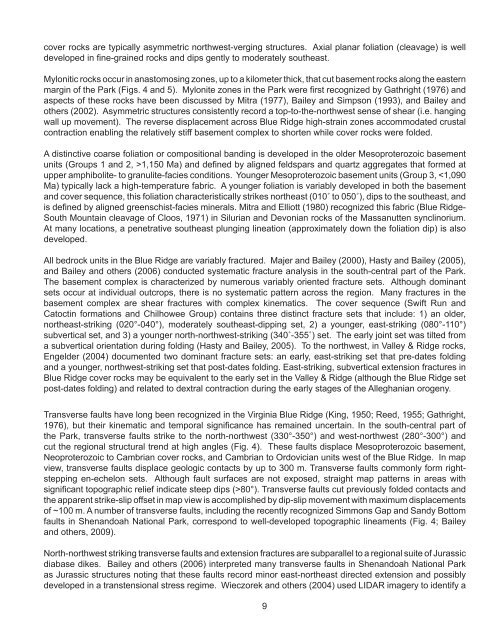Geology of the Shenandoah National Park Region - Csmres Jmu ...
Geology of the Shenandoah National Park Region - Csmres Jmu ...
Geology of the Shenandoah National Park Region - Csmres Jmu ...
Create successful ePaper yourself
Turn your PDF publications into a flip-book with our unique Google optimized e-Paper software.
cover rocks are typically asymmetric northwest-verging structures. Axial planar foliation (cleavage) is well<br />
developed in fine-grained rocks and dips gently to moderately sou<strong>the</strong>ast.<br />
Mylonitic rocks occur in anastomosing zones, up to a kilometer thick, that cut basement rocks along <strong>the</strong> eastern<br />
margin <strong>of</strong> <strong>the</strong> <strong>Park</strong> (Figs. 4 and 5). Mylonite zones in <strong>the</strong> <strong>Park</strong> were first recognized by Gathright (1976) and<br />
aspects <strong>of</strong> <strong>the</strong>se rocks have been discussed by Mitra (1977), Bailey and Simpson (1993), and Bailey and<br />
o<strong>the</strong>rs (2002). Asymmetric structures consistently record a top-to-<strong>the</strong>-northwest sense <strong>of</strong> shear (i.e. hanging<br />
wall up movement). The reverse displacement across Blue Ridge high-strain zones accommodated crustal<br />
contraction enabling <strong>the</strong> relatively stiff basement complex to shorten while cover rocks were folded.<br />
A distinctive coarse foliation or compositional banding is developed in <strong>the</strong> older Mesoproterozoic basement<br />
units (Groups 1 and 2, >1,150 Ma) and defined by aligned feldspars and quartz aggregates that formed at<br />
upper amphibolite- to granulite-facies conditions. Younger Mesoproterozoic basement units (Group 3, 80°). Transverse faults cut previously folded contacts and<br />
<strong>the</strong> apparent strike-slip <strong>of</strong>fset in map view is accomplished by dip-slip movement with maximum displacements<br />
<strong>of</strong> ~100 m. A number <strong>of</strong> transverse faults, including <strong>the</strong> recently recognized Simmons Gap and Sandy Bottom<br />
faults in <strong>Shenandoah</strong> <strong>National</strong> <strong>Park</strong>, correspond to well-developed topographic lineaments (Fig. 4; Bailey<br />
and o<strong>the</strong>rs, 2009).<br />
North-northwest striking transverse faults and extension fractures are subparallel to a regional suite <strong>of</strong> Jurassic<br />
diabase dikes. Bailey and o<strong>the</strong>rs (2006) interpreted many transverse faults in <strong>Shenandoah</strong> <strong>National</strong> <strong>Park</strong><br />
as Jurassic structures noting that <strong>the</strong>se faults record minor east-nor<strong>the</strong>ast directed extension and possibly<br />
developed in a transtensional stress regime. Wieczorek and o<strong>the</strong>rs (2004) used LIDAR imagery to identify a<br />
9


